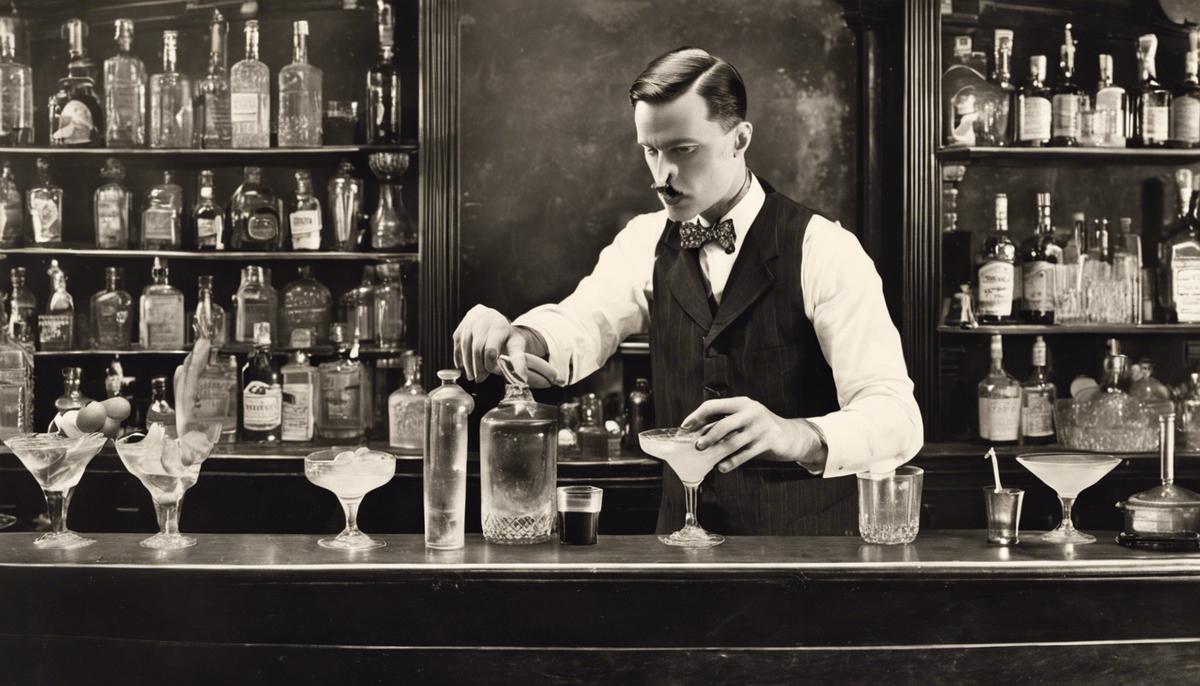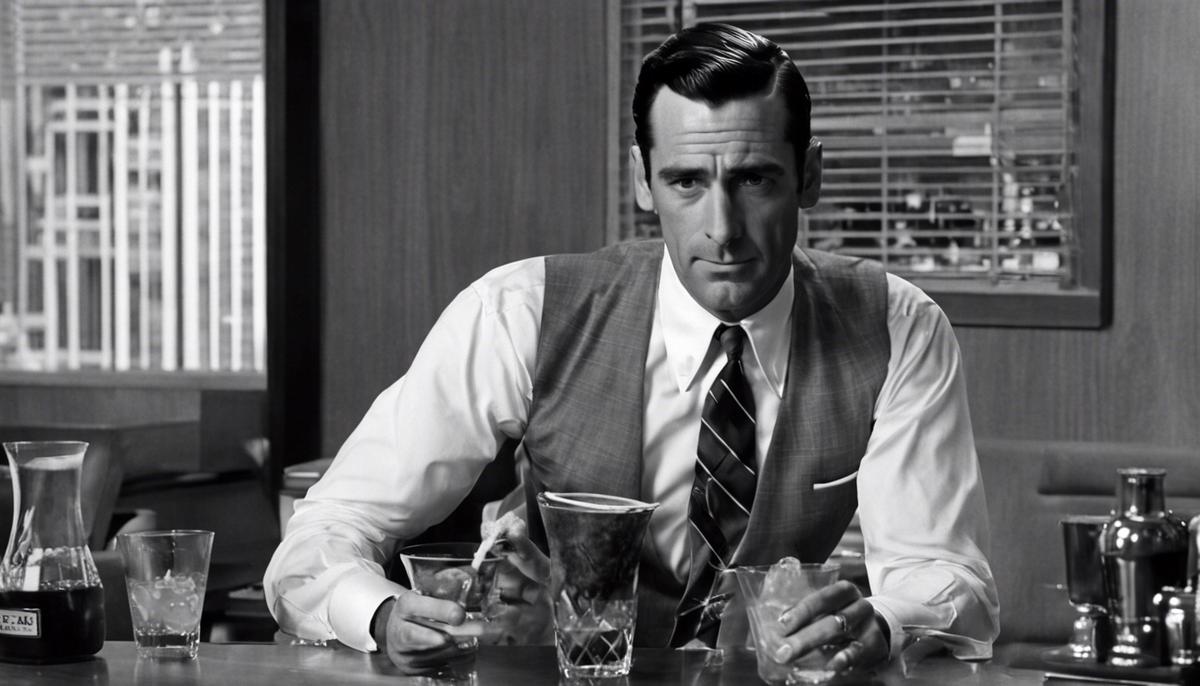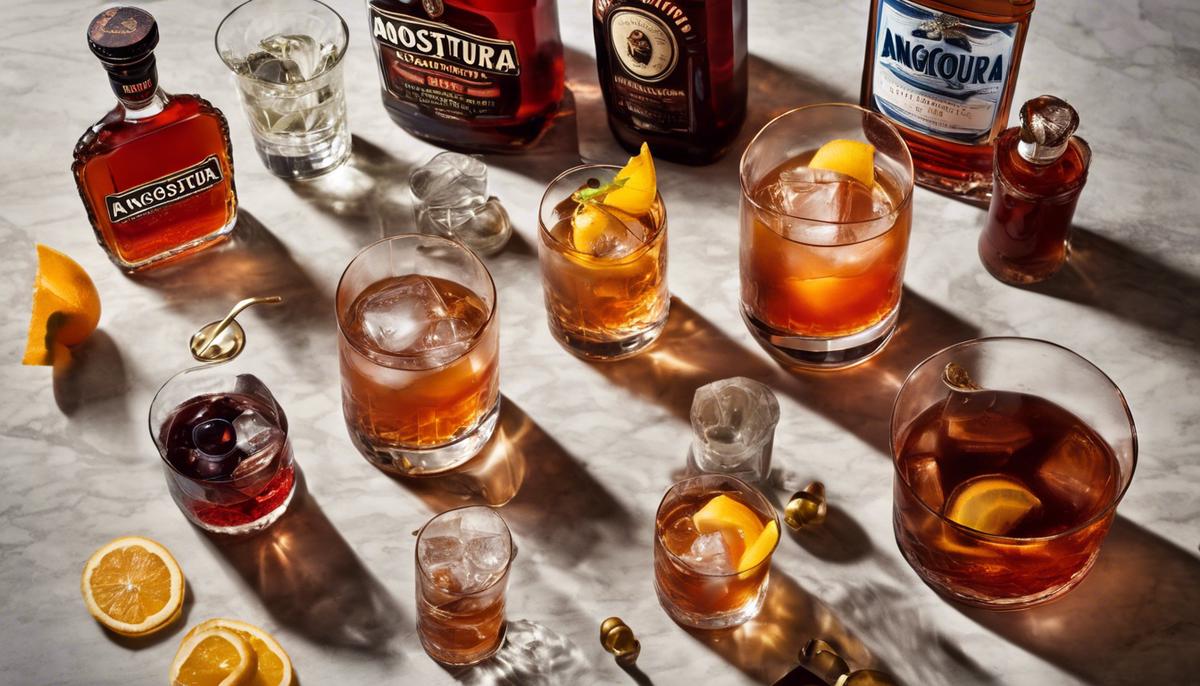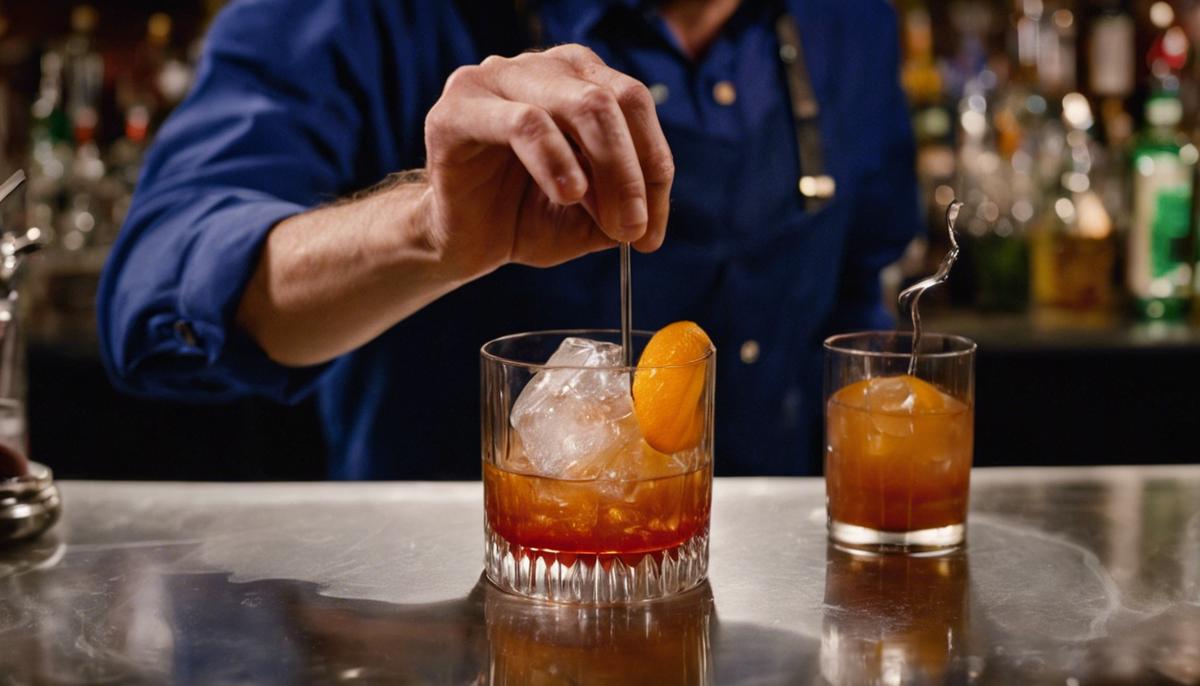Origins and Evolution
The Old Fashioned cocktail holds a prestigious place as a pioneering spirit concoction, with its inception dating back to the early 19th century. Initially, this drink was a straightforward blend – spirit, sugar, water, and bitters, marking the essence of cocktail crafting. The narrative takes off in the 1800s, where it wasn’t just about stirring these ingredients; it was about setting the foundation for what mixology meant.
As the years rolled on, the simplicity of the Old Fashioned began to encounter a wave of complexity. The late 1800s saw the advent of the “Improved” Whiskey Cocktails, introducing dashes of absinthe, curacao, and maraschino into the mix. This period heralded an era where bartenders began to infuse their own flair into traditional recipes, albeit not to everyone’s liking. There were those who longed for the unembellished simplicity of the past, requesting their drinks in the “old fashioned” style, devoid of modern embellishments.
Prohibition brought another twist to the tale of the Old Fashioned. To mask the harshness of bootleg whiskey available at the time, fruits started to make their appearance in the concoction. Orange slices and maraschino cherries didn’t just add flavor; they eased the rough edges of subpar spirits. This adaptation showed the cocktail’s resilience, transforming necessity into an enduring trend.
However, post-Prohibition America witnessed a return to basics. With the availability of higher quality spirits, the Old Fashioned reclaimed its classic stature, focusing once again on showcasing premium bourbons and ryes. Through these adjustments, the cocktail mirrored the times, adapting to spirit trends and public taste, yet always revering the original recipe at its core.
Transitioning from a purely whiskey-based beverage, bartenders began to explore other spirits. Gin and mezcal made their way into the Old Fashioned, showcasing the cocktail’s flexibility and the creativity of those behind the bar. The concept of “riffs” on the classic formula became an avenue for innovation within traditional boundaries. These adjustments weren’t just nods to contemporary tastes but acknowledgments of the Old Fashioned’s foundational role in cocktail history.
Amidst its evolution, the Old Fashioned sustained its identity – a testament to mixology that balances the art of tradition with the embrace of innovation. Through its simplicity and adaptability, it’s no wonder that this seminal cocktail continues to enchant both purists and experimentalists alike. Despite variations and trends, the Old Fashioned’s essence remains untouched; spirit, sugar, water, and bitters at its heart – a timeless concoction that transcends the era of its birth.

Cultural Impact
The Old Fashioned, with its storied past and robust character, has weaved itself into the fabric of American culture, emerging as a beacon of sophistication and a revered tradition in the cocktail landscape. It’s a drink that carries an air of timelessness, complementing both the dimly lit corners of age-old taverns and the polished counters of modern bars with equal grace. Much of its contemporary charm and renewed acclaim can be attributed to its portrayal in media, most notably in the celebrated television series, “Mad Men.” Like the sharply dressed and effortlessly cool Don Draper, the Old Fashioned has become synonymous with a stylish allure that’s both vintage and avant-garde.
While its resurgence in popularity owes a nod to “The Mad Men Effect,” the Old Fashioned’s appeal is far from a fleeting trend. It embodies a deep-seated symbol of traditions cherished and the continuous journey of refinement. Its core principles—a harmonious blend of spirit, sugar, bitters, and water—serve as a canvas for creativity, allowing it to evolve while retaining its signature ethos.
Within the broader tapestry of American cocktail culture, the Old Fashioned occupies a pronounced role, epitomizing the art of cocktail making and savoring. Amid this renaissance, regional variations have surfaced, further enriching its narrative. The Wisconsin Old Fashioned—a unique variant that strays from the canonical whiskey base in favor of brandy, finished with a muddle of fruit and topped with soda or sweet lemon-lime mix—reveals a state’s unique palate and historical preferences, showcasing how local traditions can influence and redefine a classic, binding it even more deeply to the community’s cultural fabric.
The Old Fashioned’s role in American culture is not merely a testament to its enduring appeal but also to its adaptability—its capacity to morph and thrive across different epochs and locales. It has secured its place as a staple in the milieu of mixology, not just for its rich complexity but for its embodiment of elegance and craftsmanship. In celebrating this cocktail, one isn’t merely toasting to a mix of ingredients but to an icon that has mirrored cultural shifts, championing sophistication and innovation through every sip.
As we construct our own versions or adhere to the time-honored recipe, we partake in a tradition that spans centuries, engaging with a heritage that goes beyond the clink of ice against glass or the twist of citrus—immersing ourselves in a narrative steeped in history yet ever-evolving. To relish an Old Fashioned is to savor a piece of Americana, paying tribute to an indelible legacy that continues to inspire and unite aficionados in bars and homes across the nation.

Modern Variations
The Old Fashioned cocktail becomes a playground for the inspired mixologist and a testament to the dynamic landscape of the cocktail industry. The timeless recipe acts as a guiding star, while contemporary twists cater to an ever-evolving palate desiring novelty and customization. Among these modifications, the choice of spirit sings the loudest, seguing from its whiskey foundations to embrace the bold profiles of tequila, rum, and even the smoky whispers of mezcal, yielding variations such as the Tequila Old Fashioned and the lauded Oaxaca Old-Fashioned, each lending a distinct harmony of flavors to the basic blueprint.
The inclusion of different sweeteners adds yet another layer of complexity and taste. Where once simple syrup or a lone sugar cube sufficed, now agave, honey, and maple syrups enter the mix, adorning each sip with their uniquely rich textures and tastes. These alternatives not just sweeten the deal but also infuse it with deeper notes, making every iteration both a novelty and a homage to the original.
Bitters, too, have ventured beyond the classic Angostura, exploring a world of flavors ranging from chocolate to orange, lavender to walnut. These potent potions, used sparingly, are integral in transforming a traditional Old Fashioned into something refreshingly contemporary. Each type of bitters interacts differently with the base spirit and the chosen sweetener, offering a kaleidoscope of possible outcomes, and making every Old Fashioned remarkably singular.
The garnish, while often considered merely an embellishment, holds its ground in the creation of modern variations. A departure from the conventional orange peel or cherry, bartenders now experiment with grapefruit peels, dried fruits, or even a sprig of rosemary or thyme, adding an aromatic dimension that engages not just taste but also smell, fully immersing one in the crafted experience.
This voyage into the new territories of the Old Fashioned is not a rebellion against its essence but rather an exploration that respects its core. The spirit of the original mix – a balance of sweetness, bitterness, water, and alcohol – remains untouched, even as the ingredients morph. Each variant shines a light on the drink’s inherent versatility and reaffirms its status as a cornerstone of cocktail culture.
The contemporary iterations of the Old Fashioned reflect broader trends within the cocktail industry: a collective push towards personalization, an emphasis on quality ingredients, and a nod to the past even as we barrel boldly into the future. Mixologists are akin to modern-day alchemists, blending tradition with innovation, ensuring the Old Fashioned continues to captivate imaginations and taste buds alike.
The Old Fashioned serves as both anchor and sail in the vast sea of cocktails — deeply rooted in tradition yet eagerly catching the winds of change. Its variations tell stories of cultural shift, regional preference, and individual creativity, marking each glass not just a drink but a living chronicle of the enduring human connection to craft and flavor. In relishing these modern variations, connoisseurs and casual drinkers alike participate in a ritual that transcends time — celebrating not only the cocktail’s storied past but its vibrant present and promising future.

Making the Perfect Old Fashioned
Crafting the classic Old Fashioned is akin to orchestrating a symphony where each ingredient plays a pivotal role, contributing its unique tone to create a harmonious balance. The magic lies not in the complexity of the components but in the quality and the precise interplay of flavors. As we embark on the journey to perfect this esteemed concoction, the wisdom of seasoned bartenders echoes the sentiment: the quality of each ingredient is paramount.
The bourbon or rye, the soul of the cocktail, should be chosen with care. Experts advocate for using a spirit that not only pleases the palate when sipped neat but also has the backbone to stand up against the sweetness of the sugar and the pungency of the bitters. This foundation sets the stage for a robust and flavorful experience.
Next, we address a topic that often stirs passionate discourse among aficionados: the muddling of fruit. Traditionalists argue that the original Old Fashioned calls for a simple garnish of citrus peel, without the intrusion of muddled fruit. Contrarians, however, welcome the subtle sweetness and complexity that a cherry or orange slice imparts when gently pressed. Although opinions may vary, the consensus leans towards moderation. If opting to include fruit in the muddle, do so judiciously, ensuring that the essence rather than the overpowering fruitiness comes through.
The sweet component, while seemingly minor, plays a significant role in counterbalancing the bitterness of the bitters and the potency of the spirit. Whether a demure sugar cube, a teaspoon of simple syrup, or an alternative sweetener, the key is achieving a delicate equilibrium. The sweet should whisper, not shout, complementing the spirit and enhancing the depth of the cocktail.
Bitters, the spice cabinet of mixologists, add a layer of complexity and depth. Angostura remains the stalwart choice, though venturing into orange, chocolate, or other artisanal varieties can yield delightful variations. The trick is to add enough to introduce a bitter contrast and aromatic depth without overpowering the drink.
Ice, often overlooked, is crucial in achieving the perfect dilution and chill. A large cube or sphere melts slowly, chilling the drink while minimizing dilution, preserving the integrity and strength of the cocktail.
The art of crafting the perfect Old Fashioned culminates in the ritual of mixing. Stirring gently over ice combines the elements without bruising the spirit, ensuring a smooth, cohesive blend. The garnish, typically a twist of orange or lemon peel expressed over the drink and rimmed around the glass, lends a final aromatic flourish.
In pursuit of the perfect Old Fashioned, experts underscore that it’s not solely about adhering to a strict recipe but understanding and respecting the interplay of ingredients. Balancing sweetness, bitterness, and strength is akin to a dance, with each component stepping forward at the right moment. The journey to perfection affords endless learning and experimentation, each glass an opportunity to hone one’s craft.
As we embrace the heritage and evolution of the Old Fashioned, we celebrate not only a cocktail but a timeless tradition of craftsmanship and creativity. Whether you’re a steadfast purist or a bold experimenter, the quest for the perfect Old Fashioned is a testament to the enduring allure and complexity of this classic cocktail. It invites us to savor each sip, ponder each nuance, and appreciate the symphony of flavors that have captivated connoisseurs for generations.

The Old Fashioned is more than just a cocktail; it’s a story of resilience, adaptability, and elegance that continues to inspire and unite aficionados across generations. Its simplicity, coupled with the depth of flavor, makes it a timeless masterpiece in the world of mixology. As we savor each variation, we celebrate a rich tradition that has seamlessly blended the art of the past with the innovation of the present.
- Simonson R. The Old-Fashioned: The Story of the World’s First Classic Cocktail, with Recipes and Lore. Ten Speed Press; 2014.
- Rothbaum N. The Old-Fashioned. In: The Oxford
Writio: Your AI content writer for website publishers and blogs. This article was crafted by Writio.
Leave a Reply